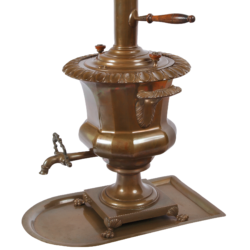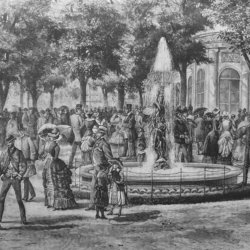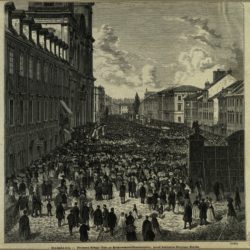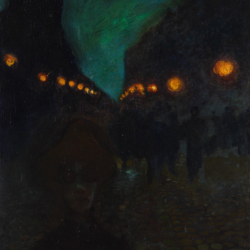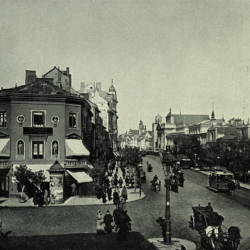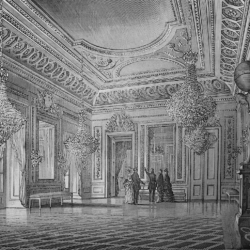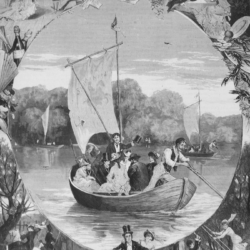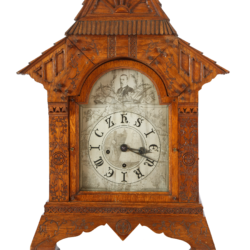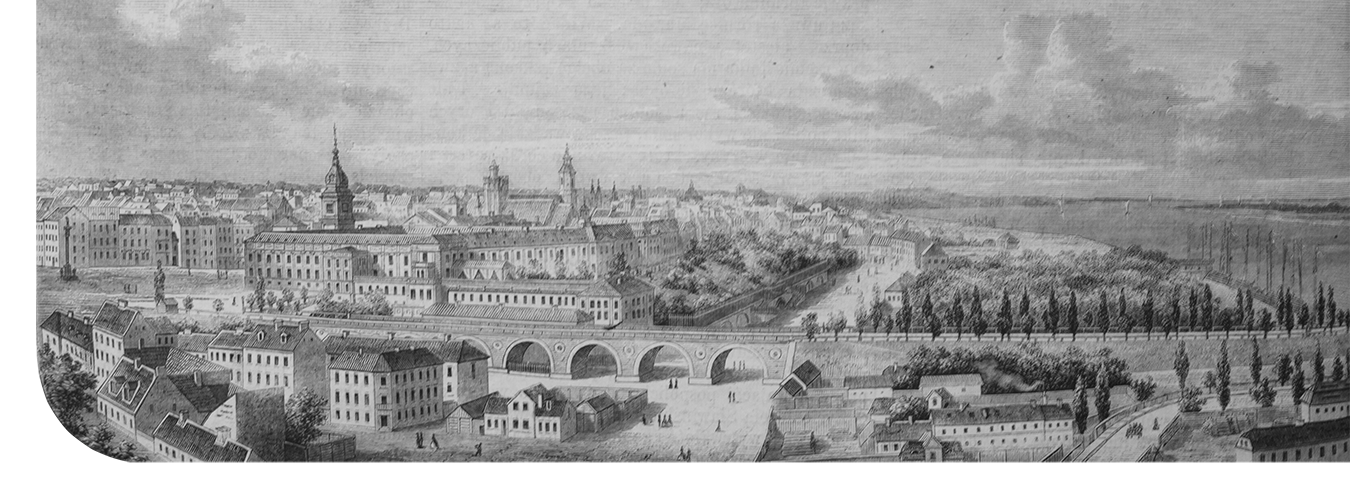
Warsaw’s mental space
Reading Sienkiewicz’s columns, one could draw a map of points that are important from a narrative perspective. This would be a cultural map of Warsaw at the end of the 19th century, indicating places important in public life.[1] The obvious difference between an analysis of space in the novel and creation of a literary map, on the one hand, and a delineation of a network of points important for the imaginary space, functioning within a specific geographical area, on the other, results, firstly, from the specific nature of the work (the journalistic text was a record of real events taking place in a real location), and secondly, from the essence of the phenomenon itself. The list of places in Sienkiewicz’s articles that are important for the life of the city and can be mapped out include the social meeting area in Saski Garden or in Bartels’s zoo, dancing balls in the City Hall, artistic events in Dolina Szwajcarska (Swiss Valley Park), exhibitions at Krakowskie Przedmieście and nearby Nowy Świat Streets, periodic events in Ujazdów, and summer gardens in Saska Kępa. The cultural life of the city is mainly concentrated in its central area, and Krakowskie Przedmieście is the main route of cultural entertainment (including Alexander Krywult’s Salon in Europejski Hotel, the Museum of Industry and Agriculture, Warsaw Charity Society, and since the 1880s – Gracjan Unger’s Salon of Fine Arts in the Potocki Palace, Resursa Obywatelska Palace). The descriptions also concern schools, hospitals, societies, orphanages, and social activity centers; that is why specific locations recur in the texts. Calling for support for individual initiatives, the writer starts a narration representing a given site – Alexander Park (today’s Praski Park) and Saski Garden, are mentioned in the context of botanical and zoological garden projects (as a point of reference), Vistula areas are referred to in connection with the problem of river regulation or water supply system, the main urban routes (Krakowskie Przedmieście, Marszałkowska Street, Old Town) – in the context of street lights and traffic regulation.
Stanisław Fita wrote about the topographic representation in Sienkiewicz’s journalistic texts:
Most often he [Sienkiewicz] led the readers along Krakowskie Przedmieście and Nowy Świat, Marszałkowska and Świętokrzyska, Miodowa, Wierzbowa and Niecała, Królewska and their cross streets, through Saski and Teatralny Squares. He also did not avoid the Old and the New Town. He often wrote about Warsaw parks: Saski Garden, Łazienki Park, and Botanical Gardens. But he also mentioned Saska Kępa. It should be noted that he did not forget about Praga and its problems, the-then Alexander Park, part of which was to be used for a zoo, about the need for a hospital in this district, about philanthropic events and folk games, about the “Antokol” open-air theater and “Pod Rakiem” restaurant. […]
The names of larger and smaller theaters often appear, as well as those of concert halls, exquisite restaurants and confectioneries, and social clubs. They are occupied mostly by the “elegant world” of Warsaw rather than the anonymous crowd; attractive places dominate over neglected backstreets. [2]
Attempts at mapping Warsaw from Sienkiewicz’s columns are based on the competence of the narrator-guide. The narrator is not a walker or an individual set in the middle of a crowd and in the unrecognizable text of the city (as it often happens in 19th-century narratives), but a commentator shaping his readers’ opinions (appealing for support for various initiatives and improvements of the technical condition of the city). A question arises as to whether the narration of the columns truly “leads the reader” – as the researchers have pointed out – or “throws the reader” between particular points on the city plan, points that are important from the perspective of the addressed topic and that are conditioned by the area in which the cultural life of Warsaw was concentrated. Walks were a form of cartographic mapping, setting the city landmarks, as Kevin Lynch pointed out in The Image of the City,[3] and that led to the creation of mental maps related to the space of the city. Pointing to the imaginary space in Sienkiewicz’s columns opens slightly different threads – it is closely connected with the real space but does not only depend on the wandered area. The subject matter of the texts refers to the issues of general public interest, thus the space of Warsaw is a common space, a space conditioned by the existence of a complex society (Sienkiewicz repeatedly uses the form of the first person plural). If one reaches for a map of the city of that time in order to visualize the object of description, the shape of Warsaw that is superimposed on the cartographic grid is the one depending on the social groups living in given areas, as well as the one stretching between the points important for cultural life. Such a reading of the columns provokes us to reach for John Bryan Harley’s[4] critique of cartography, which points to the textual nature of the map and the possibility of using it as a research tool. The social rules to which the code of cartographic transcription is subordinated are replaced here by the rules of selecting objects according to their importance from the perspective of the column writer – the commentator of social customs.
Julian Krzyżanowski wrote:
Closing the remarks about Warsaw in the work of the great master of the novel, one should finish with a reference not to Legiony (The Polish Legions), but to a charming sketch “Wspomnienie” (A memory), written shortly before his death. It is Sienkiewicz’s farewell to the truly beloved city, an object of his creative love not by birth, but by choice.[5]
In a different part of his study about Sienkiewicz’s Warsaw, Krzyżanowski asked “What kept him in Warsaw, where, especially after his return from America, he felt very bad as the letter to Witkiewicz proves, where he explicitly painted the cultural misery of the city that was being transformed by the historical events from the capital into a provincial hole?”[6] Małgorzata Trzeciak, on the other hand, claimed that the author of the columns strongly criticized Warsaw society, and revealed his attitude towards the city in the columns and his correspondence: “One can read from them the obsession with the cruelly and systematically destroyed intellectual life of the city, the futility of all actions aiming at its modernization and improvement.”[7] Janina Kulczycka-Saloni emphasized that Sienkiewicz described contemporary Warsaw from the perspective of its apparent charm and real shadows. “The atmosphere of Warsaw bored Sienkiewicz the journalist quickly, so he left it without regret”[8] – the researcher stated. This is a key sentence, which accounts for the reconciliation of the above-mentioned contradictory interpretations. Shortcomings in the technical condition of the city, which Sienkiewicz regretted, are connected with the problems on the level of mentality. What determines the writer’s negative attitude towards the city is its atmosphere, Warsaw in its mental dimension. Whereas the streets of the Old Town, the house behind Świętojańska Street, Piwna Street with small shops and the church with “its gothic ribs of the nave, altars, monuments, portraits, and especially statues of knights in armor” were the things that “attracted the writer enormously.”[9] The city in its physical dimension was an important element of his youth. However, the physical dimension of the city does not concern its technical aspects, but the rank of the objects having their own history and constituting cultural continuity. Sienkiewicz left “Wspomnienie” (A memory) written in 1916 to the readers of Tygodnik Ilustrowany just before his death. In the text, he referred to the painting of St. John’s Church by Palma il Giovane and emphasized that the church is visited by all those “who come for the service or to draw in the breath of the past centuries of strength, glory, and freedom.”[10]
Przypisy
- It is worth stressing that its nature would be different from literary maps representing the trajectory of characters’ movement in literary works and the relationship between real space and the one presented in the work as the spatial relations emerging from the columns have a different meaning than in the case of novel chronotopies. For the purposes of comparison, we can mention projects concerning literary cartography such as Walking Ulysses: Joyce’s Dublin Today, http://ulysses.bc.edu/ [accessed on 01-05-2018], directed by J. Nugent; A Literary Atlas of Europe (Mapping and Analysing the Geography of Fiction with Interactive Tools), directed by L. Hurni and B. Piatti, http://www.literaturatlas.eu/?lang=en [accessed on 01-05-2018].
- S. Fita, op. cit., p. 11.
- K. Lynch, op. cit.
- J. B. Harley, “Deconstructing the Map,” Cartographica 1989, vol. 26, no. 2.
- J. Krzyżanowski, op. cit., p. 81.
- Ibidem, p. 16.
- M. Trzeciak, “Henryk Sienkiewicz,” in Warszawa pozytywistów [Warsaw of the Positivists], ed. by. J. Kulczycka-Saloni, E. Ihnatowicz, Warsaw 1992, p. 157.
- J. Kulczycka-Saloni, “Sienkiewicz a Warszawa” [Sienkiewicz and Warsaw], Przegląd Humanistyczny 1967, vol. 3, p. 51.
- H. Sienkiewicz, Dzieła [Collected Works], vol. 40, p. 152.
- Ibidem, p. 155.


